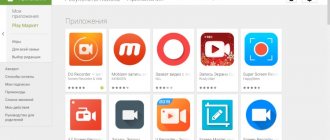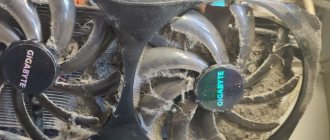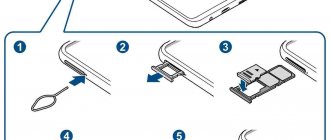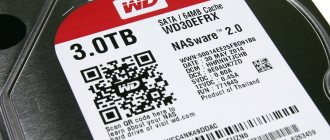Everything about protective glass on your phone and how to glue it
The display is the most vulnerable part of any gadget. If you carry your smartphone without a case, we recommend using additional screen protection from scratches, chips and shocks. If you stick a protective glass on your phone, it will preserve its appearance for a long time and protect it in case of an accidental fall. To save your budget, you can do a simple procedure yourself.
What is safety glass?
Protective glass is a layer of tempered material with a thickness of 0.25 to 0.33 mm. It has a flexible structure and high density. Very durable, even if it breaks when dropped, it does not shatter into fragments, the bottom layer holds the pieces. Produced for most modern smartphone models and in a wide range of prices.
Protective glass consists of five layers:
- oleophobic – protects against fingerprints and grease stains;
- protective – gives strength and stability when falling;
- anti-glare – removes sun glare so you can comfortably use your phone in natural light;
- restraining – holds fragments in case of mechanical damage;
- silicone – securely fixes the glass to the screen.
Before you stick the protective glass on your phone, you need to match it to your smartphone model. Unlike film, it is difficult to cut due to its high strength.
When choosing, pay attention to the presence of an oleophobic coating that prevents grease stains from your fingers. Some manufacturers supply a special cloth for polishing the surface.
On a note!
The protective glass does not reduce the sensitivity of the sensor and does not distort color rendition.
Protective glass: advantages and disadvantages
Protective glass is stronger than any film, even the highest quality, and can prevent not only simple scratches. Manufacturers of such glass often claim that their product will not crack even after being hit with a hammer. It’s not worth checking, but it’s definitely certain that if the smartphone falls, such a protective glass will absorb all the energy of the impact and the smartphone screen will remain intact.
It is important that glass in no way reduces touch sensitivity or screen brightness.
But such protection is much more expensive than film, and your smartphone model must be relatively popular: protective glass is not as universal as films and does not fit many models at once.
Operating principle of protective glass
Protective glass for smartphone screens is designed taking into account mechanical impacts of varying strength:
- withstands scratches from keys and abrasions when using the phone without a case;
- with a weak impact, it dissipates the force along its plane;
- with strong impact it absorbs and cracks.
If the impact force was very strong, the part goes to the screen. The glass is strong enough, damage to the screen will be minimal or unnoticeable during operation.
What are the pros and cons of protective glass?
Manufacturers are improving the material for making screens, but if there is an accidental impact, even the best glass will not withstand the load and will crack. Replacing the display will cost 30-50% of the cost of the smartphone. It is cheaper to stick on high-quality protective glass, but you should remember that such protection does not provide a 100% guarantee.
pros
Undoubted advantages of protective glass:
- softens the impact of the asphalt flat;
- in most cases, with a strong impact, only the top layer cracks, the screen remains intact or with minimal cracks;
- On sale there are options for displays with 2.5V and 3D technology.
Replacing glass will cost tens of times less than the screen.
Minuses
Several disadvantages of protective glasses:
- a wide selection is presented only for flagships and popular models;
- owners of new products have to wait 1-2 months for glass to appear on sale;
- If the cover is fitted with high precision, it may not close due to the thickness of the glass.
The protection does not prevent the phone from falling on its end.
Protective glass - fitting and fixation
The first thing you need to do is adjust the glass exactly to the size of your smartphone screen. Just place the glass on your phone. The protective film should be inside; it is under it that there is an adhesive composition that facilitates fixation with the screen of the mobile device.
Now center the protective glass so that its edges do not extend beyond the display. Everything should be neat and beautiful. The next step is to secure the glass from the side to the smartphone body using regular tape. You can fix it on both the right and left sides, whichever is more convenient for you.
Cleaning the protective glass from dust
So, our “protection” is fixed, let's move on. We turn the glass over to clean the smartphone screen from dust and small debris. The glass package must include 2 bags of napkins and a paper sticker.
Open package No. 1, it contains a damp cloth soaked in an alcohol-containing solution. Carefully wipe the display of your mobile phone. We take package No. 2, there is a dry napkin there. We wipe the screen again and remove all the moisture from wiping with a damp cloth.
For final cleaning, take out the paper sticker that comes with the protective glass. Peel off the paper base from it and pass it over the entire surface of the display module. The sticker will remove microscopic dust residues.
Glass sticker for screen protection
The time has come for the most important phase of applying a protective glass sticker to a smartphone. Carefully remove the protective film from our precious piece of glass and apply it to the display. Then we observe how the glass begins to attach to the screen; there is no need to touch it at this moment.
That's it, the procedure is over. If there are voids around the edges of the screen, press down these places with a light touch of your finger. Tempered protective glass is glued and now the display module of your smartphone is protected from mechanical damage.
To whom this article helped, please write in the comments below, and as a sign of gratitude, I ask you to share this article on social media. networks by clicking on the buttons. All the best to you and see you soon!
- You can buy high-quality protective glass for your Samsung smartphone in the official store here!
- You can buy high-quality glass for your Xiaomi smartphone in the official store here!
What kind of safety glass are there?
To stick a protective glass on your phone, you first need to choose a suitable option. Manufacturers offer several types of glass that differ in functionality.
Full Screen
Produced specifically for phone models with 2.5D screens, it completely covers the surface and has a colored frame on the edges. The adhesive layer is located around the perimeter.
With oleophobic coating
When using your phone in bright sunlight, glare appears on the screen, distorting the image. The oleophobic coating prevents the appearance of reflections, making it convenient to use the smartphone even on the beach. The second function is protection against grease stains.
Universal
Standard glass for smartphones with a screen diagonal of 3 inches or more. A budget option for protecting a phone that is used without a case.
Matte and glossy
Frosted protective glass is suitable for using a smartphone in bright sunlight. Increases the graininess of the image and makes the picture a little darker. Glossy glass is suitable for use in any conditions.
On a note!
Protective glasses for mobile phone camera lenses are produced separately. They have a slightly convex surface, which makes the photo more realistic and voluminous.
2.5D glass
The top edge is rounded at the edges at an angle of 45 degrees. When using the phone, your finger will not cut itself on the sharp edges of the glass. Now all manufacturers use this technology for the convenience of users.
3D glass
It differs from the usual one with rounded edges and a slight convex bend. This makes the screen visually more voluminous.
5D glass
It has a dome shape and maximum grip on the screen surface. There are expensive options with bending at the edges and cheap ones without bending.
Advice!
There are glasses on sale marked 6D, 10D and higher. This is a marketing ploy to increase cost; their functionality and volumetric angle do not differ from the 3D standard.
Selecting a Protective Accessory
The range of stores selling accessories for mobile phones offers several options for protective glasses. When choosing, focus on the main technical characteristics.
Smartphone model matching
Protective glasses are made for a specific model. Unlike film, they cannot be adjusted to fit every cut on the front panel. When choosing, consider the letter next to the name. For example, gluing protective glass on a Xiaomi Redmi Note 5 phone will not work on the 7 or 8 model.
Thickness
Glass thinner than 0.25 mm does not provide sufficient impact strength, and a thickness greater than 0.33 mm will ruin the appearance of the screen.
Strength
The basic hardness of the material from which safety glasses are made is 9H. This indicator provides flexibility to absorb frontal impacts on the screen and strength to withstand a blow to the end.
No inclusions in the structure
During production, solid particles such as sand or dust sometimes get into the material. When choosing, inspect the glass against the light and make sure there are no foreign fractions. The presence of small air bubbles is also considered a defect. If you want to order, buy with delivery and stick glass on your phone from Aliexpress, read customer reviews with real photos of the product.
On a note!
It is a misconception among buyers that there is no need to glue protective glass to a phone with a Gorilla Glass screen. Such a display is easily scratched even by a tiny grain of quartz sand accidentally falling into a pocket with dust.
How to glue protective glass on a phone: detailed instructions
After considering all the nuances, you should consider the guidelines regarding the correct fixation of the protector on the display. Despite the simplicity of the operation, it is necessary to take into account the responsibility, since failure to be careful will not allow you to reapply a single product, so you need to purchase a new product. Therefore, be sure to first familiarize yourself with the procedure and check that you have the necessary tools.
go to top
Prepare your smartphone and glass
Place the device on a flat surface next to the appropriate protector. Before starting the operation, you should remove all dust and dirt from the room. Otherwise, upon completion of the procedure, the ingress of foreign particles that can disrupt the visual impression of the result cannot be ruled out.
go to top
Prepare your tools
Following the above, it is advisable to purchase sets that include a napkin. In the opposite scenario, it is recommended to select standard wet wipes for cleaning electronic displays and a microfiber cloth that allows you to completely remove dust and traces of use. Additionally, regular tape, a card and scissors may come in handy.
go to top
Degrease the screen surface
Using an alcohol-based wipe, carefully clean the front panel of your smartphone to most effectively remove any remaining stains and fingerprints. Next, use dry wiping to completely remove all remaining liquid.
go to top
Stick the glass
This step is perceived as the most significant, so first remove the factory film from the tread. Then come the most difficult manipulations, since you need to hold the protector by the side edges without touching the flat surfaces. Bring the product closer to the device, ensuring that the cutouts are positioned precisely to match the sensors and keys on the front of the case. Gently place the glass on the screen to achieve an all-round seal and gently increase the pressure in the center area for a tight fit.
If you are not familiar with the process of manually gluing glass onto a smartphone panel with exactly the same boundaries, or have doubts due to lack of experience, then it is suggested to use some easy advice. Before removing the factory film from the adhesive area of the protector, it is recommended to secure it with ordinary tape so that in conclusion the product can be separated in accordance with the principle of the book. Next, clean the display and then connect the planes, while improvised clamps will significantly increase the likelihood of successful application.
go to top
Remove excess air and dust
In some scenarios, the glass will show bubbles after gluing, but do not be upset, as in practice you can use a cloth to move the accumulations towards the borders. Such measures will not eliminate the trapped dust, so you need to use a strip of tape and carefully bend the glass using a plastic card, then attach all the dirt with the sticky part and quickly remove all the tools. After making sure that all defects have been eliminated, you should thoroughly wipe the surface of the screen to ensure a reliable connection of the surfaces.
To clean surfaces, use only clear adhesive tape. Otherwise, the use of paper or colored tape significantly increases the likelihood of additional marks being formed.
go to top
How to remove protective glass from your phone
To stick new glass onto your phone screen, you need to remove the previous one correctly. Over time, the surfaces stick tightly; simply picking up a corner will make it impossible to separate the coating.
Old protective glass may have cracks, and when removed, the surface will separate in parts. It is strictly forbidden to use a knife - if you move awkwardly, the blade will scratch the screen. Silicone suction cups can damage the integrity of the touch module and disrupt its fixation with the phone body.
Correctly remove the old one in order to stick the protective glass on the phone yourself, you need to do this:
- take a strong thin thread;
- select the corner of the glass that has begun to peel off;
- move the thread to the second corner, separate it along the narrow side of the screen;
- When the edge comes off, carefully move the thread until the protection is completely separated from the display.
Wipe the screen, remove traces of chips from the old glass and proceed to gluing the new one.
How to glue protective glass yourself: step-by-step instructions
After purchasing a protective glass for your phone model, you can proceed directly to gluing. Additional tools you will need are tape, dry and wet wipes, which usually come with glass, and a plastic card.
Preparing your phone
Wipe down the table you will be working on and wash your hands, otherwise dust and dirt may spoil the result. Print out the glass packaging. Check the package, attach the glass to the phone and make sure that it fits, all the holes match the speaker and buttons. If there are no napkins included with the glass, then take dry and wet ones, as well as tape.
Place the glass on the phone, align it and secure it with two strips of tape on one side, making kind of loops. This will help you glue the glass evenly.
Sometimes a special sticker is included with the glass. It needs to be glued and peeled away from the display several times to remove any adhering dust.
Cleaning and degreasing the display
Take a damp cloth and thoroughly wipe your phone's display. Then you need to wipe the display dry with a dry cloth. After this procedure, touching the screen with your fingers is strictly prohibited.
Gluing protective glass
Make sure there is no dust or dirt on the display. Remove the film from the side that will be adjacent to the display. Now you need to act carefully; you must not touch the adhesive part of the glass. Hold the protective glass with two fingers on its edges. Lower the glass onto the display. Under no circumstances should you press it down; wait until it sticks under its own weight.
Use a plastic card to remove excess air, and then remove the protective film from the glass.
How to stick protective glass with liquid
Sometimes the protective glass comes with a sachet of gel-like liquid and a brush. It is used for so-called 2.5D and 3D displays, with rounded corners. As a result, after gluing the protective glass, white stripes form along its edges due to loose connections. The liquid is used to fill voids and remove these streaks, acting as a sealant. It is usually applied with a brush.
How to avoid dust when sticking glass
If a speck of dust gets under the glass, you will have to re-glue it. Prepare the room and surfaces before gluing.
- Give the room a wet cleaning, ventilate it and wipe the table with a damp, clean, lint-free cloth. Wash your hands thoroughly, degrease with alcohol or a special liquid.
- Carry out the gluing in the bathroom, there is high humidity here. You can first take a hot shower; the steam will bind the dust and make the room almost sterile.
Wear short sleeves and minimal lint.
How to stick protective glass
The gluing process is simple, the most important thing is preparation of the room and care. Unlike film, glass can be glued to a mobile phone several times. The protection is attached by the adhesion of the materials, and not by an adhesive backing.
Prepare your tools
Level the surface on which you will work and prepare everything you need:
- microfiber cloth;
- paper tape;
- sharp scissors;
- display cleaner or alcohol;
- plastic card.
Remove the old case from your phone and turn on a bright light so you can see the tiny air bubbles when sticking it on.
Preparing the screen surface for glass sticker
The set of protective glass includes two napkins. One is impregnated with alcohol to degrease the surface of the phone screen. Wipe the display thoroughly, then polish with a second microfiber cloth.
If the kit does not include a degreasing wipe, before sticking the protective glass on the phone, use tape to remove all dust and dirt from the surface. Cut a piece, stick it on the screen and remove it, repeat 2-3 times.
Gluing protective glass
Without removing the films, first carefully try the glass on the surface of the phone so that all the holes match.
- Cut small pieces of tape and attach them alternately to the glass and back cover of the smartphone.
- Check the alignment of all the gaps several times by folding back the glass and covering the screen with it, moving the tape if necessary.
- Once again, degrease your hands and the surface of the screen with a special liquid and polish, wait 4-5 minutes until completely dry.
- Remove the protective film from the glass and carefully place it on the display. Smooth all surfaces with a plastic card, squeezing air to the edges.
When finished, remove the tape from the back of the phone and the glass surface.
Important!
If done correctly, the screen will be uniformly dark without bubbles.
Tested filler for safety glass
We wipe the screen of the iPhone 11 Pro Max with the terrible wipes from the protective glass kit.
You can’t take a good photo of yourself, so I asked another person to stick a simple glass on my iPhone 11 Pro Max using a placeholder.
The process is almost the same as the standard: I cleaned the screen with napkins, made sure there was no dust on the screen, peeled off the glass and, without turning the adhesive side up, carefully and quickly plopped it onto the iPhone.
Do you see any air bubbles around the edges? These may be in the center or on one edge due to an imperfection in the protective glass or just a slightly uneven sticker. The filler liquid fights them.
You cut the “dropper”, lift the glued glass by the edge closest to the “bubble” and squeeze out just a little (!) of liquid inside. Stick the glass back:
Thanks to physics, the liquid “flattens” inside the glass, squeezing air bubbles out and filling the empty space. Since it is transparent, then instead of a bubble or next to a dot it will now also be ... “transparent”.
That's all: no bubbles, minimum effort, perfectly laying glass without flaws. Even if a speck of dust or two gets through, the “edges” of air around them will disappear.
And the tube itself is enough for several glasses. Considering that they are mainly sold 10 pieces at a time , such a purchase will last for many years and will help protect a whole string of next generations of iPhone.
If it didn't work out
If you didn’t get it to stick straight the first time, or if there are fingerprints or lint left, try re-sticking the protective glass onto your phone.
- Remove the plate from the screen using a thread. Carefully lift one of the corners, place the thread, wind it around your fingers and pull. Hold the glass by the edges to avoid fingerprints.
- Wipe the surface with distilled water.
- Dry at room temperature.
- Reapply to the screen, carefully squeezing out any air or remaining water.
After re-sticking, rainbow streaks may appear on the display, which will disappear over time when the glass is completely dry.
Step-by-step gluing instructions
After the workplace is prepared, you need to immediately begin gluing the protection to the smartphone before dust accumulates in the room again.
The principles of placing protection on the display are different: film is more prone to damage, but when working with it it is easy to eliminate stains and air bubbles underneath, while glass is stronger, but it must be glued quickly and accurately - it is not easy to remove.
Films
If the film was purchased specifically for a specific phone model, all that remains is to glue it correctly. The universal version needs to be cut by measuring the screen: place the film on the smartphone, mark the edges with a marker, leave holes for the camera and speaker, and cut to shape with scissors.
Next you need:
- Clean the screen with a special product and remove all dust particles with a napkin. Afterwards, you should not touch the screen with your hands or touch it with a cloth.
- Any film has 3 layers. The first must be removed to connect the protection to the screen, the second - to open the final covering. First attach the film to the phone, make sure that it fits the sensor in size and cutouts. Peel off the first protective layer, holding the film itself only at the edges with your fingers.
- Apply the protective layer to the sensor carefully. You can help yourself with the edge of a plastic card.
- Now you can remove the second layer. No bubbles should form if the screen was thoroughly cleaned initially.
Glass
As in the previous case, the screen needs to be cleaned and wiped dry. Then adhere to the following algorithm:
- Peel off the bottom layer - the technological film - from the glass. Place the glass above the display so that it does not touch it yet.
- Make sure the glass is positioned correctly and, holding only the edges (to avoid fingerprints on the sticky side), lower it onto the sensor.
- The glass is self-adhesive: you don’t need to press on it or run a card over it. You only need to swipe your finger over the protected sensor once to make sure it is securely stuck to the display.
Tips for quality results
Applying the protective glass to your phone correctly is not difficult; the process takes 5-10 minutes. To avoid having to re-glue and get it right the first time, carefully read the tips from the master.
- The room should be perfectly clean and well lit. It is difficult to notice a speck of dust, but if it gets under the glass, you will have to re-glue it.
- Wash your hands thoroughly and degrease. If there is no special product, use toner for oily skin or micellar water.
- Special alcohol and flannel wipes are not included in the set of inexpensive glasses. Prepare in advance regular pharmaceutical alcohol and two pieces of lint-free cloth. Soak one to wipe the screen and glass surface, use the second dry to remove wet stains and polish.
- The kit often includes special stickers that make it easier to properly stick the tempered glass onto the phone. If you don't have them, replace them with strips of tape. It’s better to take a paper one, it’s less sticky and doesn’t leave marks on the glossy surface of the phone.
- Start gluing, having practiced several times and gotten the hang of applying protective glass to the screen. Consider the placement of buttons, holes and indicators so as not to mix up the sides.
- It is more difficult to properly stick 3D glass on your phone due to the curves of the screen. To ensure that the protection does not lag behind the edges, after gluing, take a non-woven cloth and, with moderate force, rub it along the edges of the glass where it meets the sides of the phone. Make sure there are no air bubbles left and leave for a while to set.
- Choose glass from trusted manufacturers from the online store catalog. In order for the protection to stick securely and serve for a long time, you should not save when purchasing.
On a note!
If you need to stick a protective film on your phone screen instead of glass, the procedure is similar to the instructions given in the article.
How to stick protective glass on your smartphone screen yourself
When purchasing a new smartphone, almost all users immediately select a case, film or glass for it to ensure the protection of the new device. Basically, gluing glass or film occurs in the same store where the phone was purchased or in any service center. Today we will talk about how to stick protective film or glass yourself.
What to do before gluing
To begin with, you need to wash your hands well and dry them perfectly, since in this regard your hands are your main working tool. Prepare the table surface, remove everything unnecessary and turn on the light. The surface of the table must also be clean to avoid dust from the table getting onto the film or glass.
When purchasing glass or film, the kit usually includes two bags of napkins and a cloth made of microfiber. The green bag with the word “Wet” on it contains an alcohol-based wet wipe, and the pink bag with the word “Dry” on it contains a dry one.
How to prepare your phone for gluing film or glass
If your phone already has old film or glass, the first thing you need to do is remove it. This can be done by inserting something narrow under the glass, thereby peeling it off from the screen. Alternatively, a hard business card or bank card is suitable.
When the phone screen is free, we can start preparing. First of all, you need to take out a napkin from the first bag, that is, a damp one, and gently wipe the display. Every centimeter of the screen needs to be treated; there should not be a single spot or speck of dust on it. After this, you need to open the second bag, take out a dry cloth from it and wipe the screen dry; in principle, you can wipe it with a microfiber cloth.
Shine a table lamp on the phone and take a closer look to see if there is anything superfluous left on the screen; if the screen is perfectly clean, you can start gluing the film or glass.
Glass gluing process
The first thing you need to understand is how to hold the glass in your hands correctly, you need to do this carefully, hold the edge of the glass with your fingers so as not to leave marks on it.
Usually on protective films and glass there is another film on one side that needs to be removed before gluing. When you removed the film from the glass, the side on which it was placed needs to be placed on the screen, taking into account all the cutouts for the speaker, camera and sensors.
As long as you do not press the film or glass too hard against the screen, you can adjust it to the screen parameters. Next, use any dry napkin or rag to expel all the air to the edge of the screen and you’re done.











